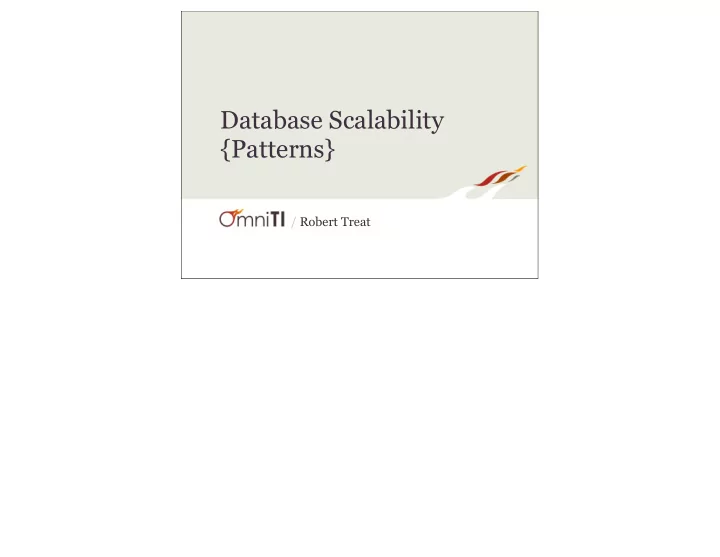

Database Scalability {Patterns} / Robert Treat
robert treat omniti postgres oracle - mysql mssql - sqlite - nosql
What are “Database Scalability Patterns?”
Part Design Patterns Part Application Life-Cycle
Part Design Patterns Part Application Life-Cycle
Part Design Patterns Part Application Life-Cycle
Part Design Patterns Part Application Life-Cycle
MyFirstDatabase
Vertical Partitioning
Vertical Scaling
Vertical Scaling
Vertical Scaling
Federated Data Storage Horizontal Partitioning “sharding” Read Slaves Multi-Master Horizontal Scaling
Read Slaves / Master - Slave Scale Read Load
Read Slaves / Master - Slave Scale Read Load writes go here!
Read Slaves / Master - Slave Scale Read Load writes go here! reads go here (or here) (or here)
Read Slaves / Master - Slave Scale Read Load database writes writes go here! data to slaves slave db slave db slave db reads go here (or here) (or here)
Read Slaves / Master - Slave Scale Read Load app writes data writes go here! everywhere memcached memcached memcached reads go here (or here) (or here)
Read Slaves / Master - Slave Scale Read Load • Typically • Full Copy of Data On Each Node • Asynchronous
Read Slaves / Master - Slave Scale Read Load • Typically • Consider • Full Copy of Data • Partial Copy • Synchronous On Each Node • Asynchronous • Don’t use a RDBMS?
Read Slaves / Master - Slave Scale Read Load • Typically • Consider • Full Copy of Data • Partial Copy • Synchronous On Each Node • Asynchronous • Don’t use a RDBMS? Requires Application Changes “easy”
Scaling Writes “not easy”
Multi-Master many different ways to implement this, few that actually work in production
Multi-Master many different ways to implement this, few that actually work in production write to any node, database syncs data
Multi-Master many different ways to implement this, few that actually work in production write to any node, database syncs data can reduce cpu, doesn’t reduce i/o
Multi-Master many different ways to implement this, few that actually work in production write to any node, database syncs data can reduce cpu, doesn’t reduce i/o failover solution not a scalability solution
Horizontal Partitioning “sharding” “SOA”
Horizontal Partitioning “sharding” “SOA”
Horizontal Partitioning • Divide schema by job operations • Move each piece to own server • Duplicate some data as needed
Horizontal Partitioning items • Divide schema by job operations • Move each piece to own server • Duplicate some data as needed forums users
Horizontal Partitioning items • Divide schema by job operations • Move each piece to own server • Duplicate some data as needed forums • You must separate dependencies in the app code first! users
Horizontal Partitioning items • Divide schema by job operations • Move each piece to own server • Duplicate some data as needed forums • You must separate dependencies in the app code first! users Each node is a new instance of vertical scaling
Horizontal Scaling • data split across servers based on algorithm • data dropped into buckets (multiple?) app magic hash algorithm
Horizontal Scaling • data split across servers based on algorithm • data dropped into buckets (multiple?) app magic hash algorithm
Horizontal Scaling • data split across servers based on algorithm • data dropped into buckets (multiple?) • someone must keep track of data, and provide lookup services app magic hash algorithm
Universal Truths of Scaling Databases Vertical Scalability is Helpful for Every Pattern Even in a horizontally scaled, fully distributed database, the number of nodes needed is affected by vertical scalability
Universal Truths of Scaling Databases New Nodes Are Never Free • Add points of failure • Add management costs • Add complexity to architecture • Add complexity to your app code
MyFirstDB V Vertical Partitioning V Vertical Scaling V Read Slaves V Horizontal Partitioning
tips plan for layered data sources read / write connections in code use schemas to separate services
THANKS! more: xzilla.net @robtreat2 omniti.com/surge (scalability conference)
Recommend
More recommend